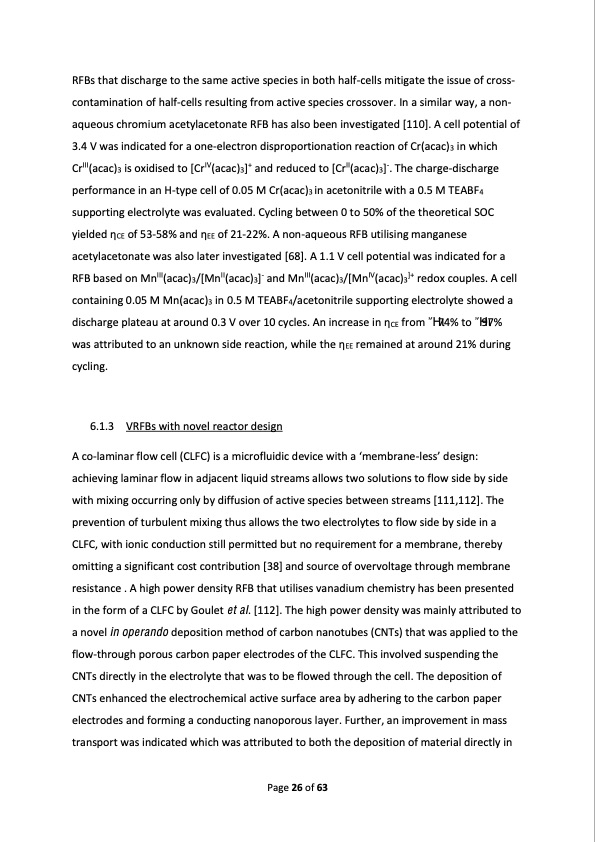
PDF Publication Title:
Text from PDF Page: 026
RFBs that discharge to the same active species in both half-cells mitigate the issue of cross- contamination of half-cells resulting from active species crossover. In a similar way, a non- aqueous chromium acetylacetonate RFB has also been investigated [110]. A cell potential of 3.4 V was indicated for a one-electron disproportionation reaction of Cr(acac)3 in which CrIII(acac)3 is oxidised to [CrIV(acac)3]+ and reduced to [CrII(acac)3]-. The charge-discharge performance in an H-type cell of 0.05 M Cr(acac)3 in acetonitrile with a 0.5 M TEABF4 supporting electrolyte was evaluated. Cycling between 0 to 50% of the theoretical SOC yielded �CE of 53-58% and �EE of 21-22%. A non-aqueous RFB utilising manganese acetylacetonate was also later investigated [68]. A 1.1 V cell potential was indicated for a RFB based on MnIII(acac)3/[MnII(acac)3]- and MnIII(acac)3/[MnIV(acac)3]+ redox couples. A cell containing 0.05 M Mn(acac)3 in 0.5 M TEABF4/acetonitrile supporting electrolyte showed a discharge plateau at around 0.3 V over 10 cycles. An increase in �CE from � 74% to �97% was attributed to an unknown side reaction, while the �EE remained at around 21% during cycling. 6.1.3 VRFBs with novel reactor design A co-������� ���� ���� ������ �� � ������������ ������ ���� � ���������-����� ������� achieving laminar flow in adjacent liquid streams allows two solutions to flow side by side with mixing occurring only by diffusion of active species between streams [111,112]. The prevention of turbulent mixing thus allows the two electrolytes to flow side by side in a CLFC, with ionic conduction still permitted but no requirement for a membrane, thereby omitting a significant cost contribution [38] and source of overvoltage through membrane resistance . A high power density RFB that utilises vanadium chemistry has been presented in the form of a CLFC by Goulet et al. [112]. The high power density was mainly attributed to a novel in operando deposition method of carbon nanotubes (CNTs) that was applied to the flow-through porous carbon paper electrodes of the CLFC. This involved suspending the CNTs directly in the electrolyte that was to be flowed through the cell. The deposition of CNTs enhanced the electrochemical active surface area by adhering to the carbon paper electrodes and forming a conducting nanoporous layer. Further, an improvement in mass transport was indicated which was attributed to both the deposition of material directly in Page 26 of 63PDF Image | Redox Flow Batteries Concepts Chemistries

PDF Search Title:
Redox Flow Batteries Concepts ChemistriesOriginal File Name Searched:
5870EAF5-2D70-44C8-A0A7-62D3A1462269.pdfDIY PDF Search: Google It | Yahoo | Bing
Salgenx Redox Flow Battery Technology: Salt water flow battery technology with low cost and great energy density that can be used for power storage and thermal storage. Let us de-risk your production using our license. Our aqueous flow battery is less cost than Tesla Megapack and available faster. Redox flow battery. No membrane needed like with Vanadium, or Bromine. Salgenx flow battery
| CONTACT TEL: 608-238-6001 Email: greg@salgenx.com | RSS | AMP |